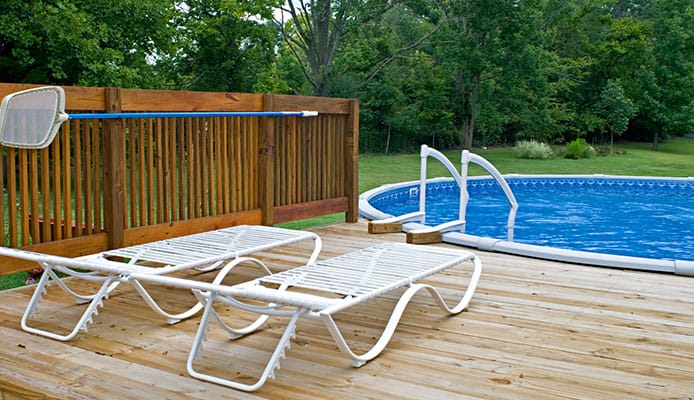
Above ground pool liners play a couple of very important roles – they hold the water in and protect the pool structure. When you get a new above ground pool, a liner is almost always included in the set. But, like all the other components, it deteriorates over time and becomes less efficient. What do you do when this happens? You get a new one.
Replacing the liner is necessary after many years of use. This isn’t hard to do, and might even make your pool better than it was. The best above ground pool liners should be tough, durable, and have the right size. Of course, it should also look great.
Our buying guide will give you pointers on what to look for when choosing, so you’ll know the easiest way find the best above ground pool pad . And, if you’re looking for some reliable and good-looking liners, be sure to check out our above ground pool liners reviews below.
OUR TOP PICK
Smartline Waves of Poseidon
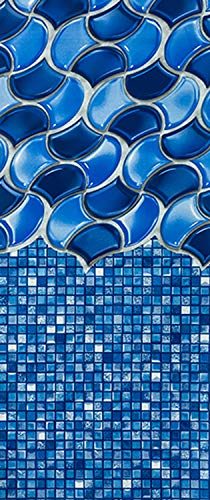
- Stand Out Features - Why We Love It
- Made of 100% virgin vinyl for improved strength
- Acrylic coating on top of vinyl makes it more durable
- Lamiclear material technology gives UV and chemical resistance
- Hand-folded in the factory to prevent creasing and wrinkles
- Great-looking Waves of Poseidon print (waves in various shades of blue)
Type: Overlap
Diameter: 24 feet
Wall height: 48 and 52 inches
Thickness: 20, 25, 30 gauge
Warranty: 25 years (limited)
EDITORS CHOICE
Quality Pool Products Great Barrier
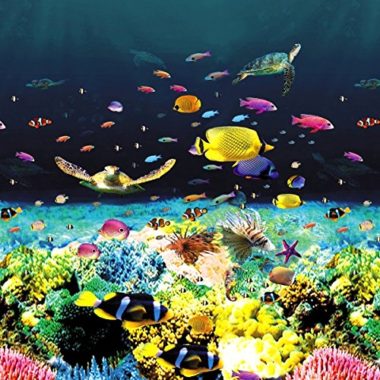
- Stand Out Features - Why We Love It
- Works great with various pool wall heights
- Lap seaming for advanced leak protection
- Unique Great Barrier Reef print looks fantastic
- Excellent resistance to UV rays and sun exposure
- Very easy to adapt to the walls and install
Type: Overlap
Diameter: 24 feet
Wall height: 48, 52, 54 inches
Thickness: 25 gauge
Warranty: 25 years (limited)
BEST VALUE
In The Swim Solid Blue
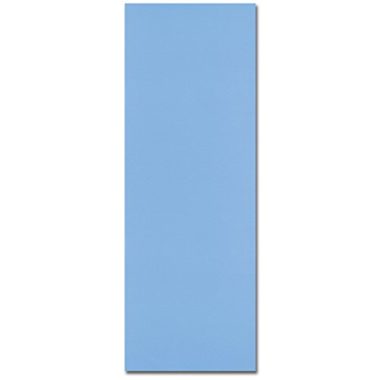
- Stand Out Features - Why We Love It
- Super-strong vinyl for increased durability
- Great color option if you like a traditional look
- Overlap design for easy setup on the top rail
- Double-welded seams reduce material wear
- Very affordable considering the quality
Type: Overlap
Diameter: 18 feet
Wall height: 48 and 52 inches
Thickness: 20 gauge
Quality Pool Products Round Overlap

- Stand Out Features - Why We Love It
- Lap seam construction with almost invisible seams
- Fits well on three different wall sizes
- Fully protected against pool chemicals and harmful UV rays
- High-grade vinyl with a 25-year warranty
- Large diameter for bigger above ground pools
Type: Overlap
Diameter: 24 feet
Wall height: 48, 52, 54 inches
Thickness: 25 gauge
Warranty: 25 years (limited)
Quality Pool Products Stoney Creek 3D
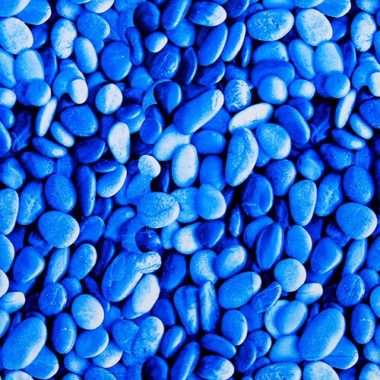
- Stand Out Features - Why We Love It
- Beautiful Stoney Creek 3D print
- Lap seams for improved tear resistance
- Longer sides for walls up to 54 inches
- Premium vinyl with 25 gauge thickness
- Doesn’t deteriorate or fade in the sun
Type: Overlap
Diameter: 18 feet
Wall height: 48, 52, 54 inches
Thickness: 25 gauge
Warranty: 25 years (limited)
How To Choose The Best Above Ground Pool Liner – Buying Guide
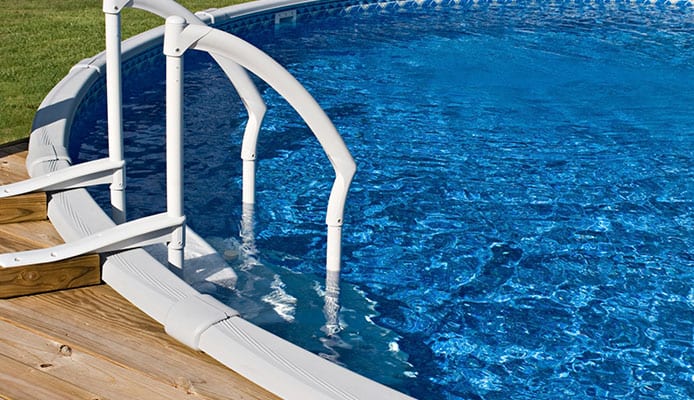
Liner Types
Three different types of above ground pool liners are available – overlap, beaded, and unibead. The main difference between them is how the liner is installed on the pool edge.
Overlap liners are simply draped over the edge and then locked in place with plastic coping and the top rail. They can be a problem to line up properly and often leave you with a piece of liner hanging on the other side. However, they are the most affordable option you can get.
Beaded liners attach to the bead receiver that is placed on the top edge. This system makes the liner very easy to install and remove. Beaded liners are available in many beautiful designs and they are easier to line up than overlap models. On the other hand, they are also a more expensive option.
Unibead pool liners are the best in terms of versatility, allowing you to install them both as a modified overlap and as a beaded liner. Most come with a J-hook on top to hang them on the edge, but with a great precision than an overlap liner. However, if you already have a bead receiver, you can cut off part of the hook and then tuck the liner into the receiver.
Measuring the Size
While it may seem obvious to point out, size is the most important aspect to get right when choosing a replacement pool liner. Manufacturers usually standardize the sizes to fit the most common pool dimensions.
Unfortunately, a surprisingly large number of people will get the size wrong and end up with a liner that is either too big or too small. This is why you need to be careful when measuring the swimming pool.
The pool height is measured in a straight line from the ground up to the top rail (make sure to remove any obstacles). If you have a round pool, you can get the diameter by measuring from one side to the other while going through the pool center.
Rectangular pools are measured similarly, but you need to know both length and width. Regardless of pool type, it’s best to do the measuring in a couple of spots. In case there are slight variations with the numbers, always go with a larger one.
Materials and Quality
Because of their function in a pool, liners need to have very high quality standards. Tearing or puncturing could lead to water leaks or dirt entering your pool. As you’ll see, the overall quality depends on the materials used as well as their thickness (which we’ll discuss in the next section).
All liners that we featured here are made out of vinyl. However, some more expensive models (like Doughboy pool liners) are made of virgin vinyl which offers a higher level of quality. Virgin vinyl is made from fresh (not recycled) plastic, which means that it is completely new and offers greater strength and durability.
Liner Thickness
The thickness is usually listed in either mils or gauges. With both of these, a larger number is better. A mil represents 1/1000 of an inch (0.001 inches). One gauge measures similar to this, but it isn’t standardized so the same number of gauges can vary in real thickness from manufacturer to manufacturer.
For most above ground pool liners, the thickness is somewhere between 20 and 25 mils. Of course, a thicker material offers more strength and durability. And while you might be drawn to go with the thickest liner possible, a liner that is too thick will be difficult to install and often has wrinkles. This is why we recommend finding a balance here.
You might also like: Swimming Pool Etiquette
Surface Texture
Despite looking great, some swimming pool liners have a completely smooth surface. While this might not seem like a problem right now, it’s very annoying when your feet are constantly slipping.
For this reason, it’s best that you get a liner that has some type of texture on the surface (even if it’s just a simple pattern). This way walking will be easier and the pool bottom will feel nicer. Luckily, all vinyl liners we talked about are great in this regard, so you shouldn’t worry too much.
Eye-catching Design
One of the best things about getting a new pool liner is that you get to choose the new color and design, and add an extra bit of personality to your pool. From solid blue liners to various tile patterns, there is a huge number of options to choose from.
And if you feel like these classic designs are a bit boring, why not treat yourself with a fun liner that has a marine life print (fish or dolphins for example). This comes down to personal preference and finding what will best suit you and the pool surroundings.
Warranty and Durability
As with any product, a warranty not only acts as insurance if anything goes wrong, but it also gives you confidence that you’re buying a well-made product. A long warranty period serves as an indicator that the manufacturer believes in the product and doesn’t expect anything to go wrong any time soon.
On average, above ground pool liners last between 5 and 10 years. This depends on several factors – UV exposure, chlorine exposure, potential damage from sharp objects and many other things. Because of this, many manufacturers offer only limited coverage, so be sure to check that too when buying a liner.
FAQs
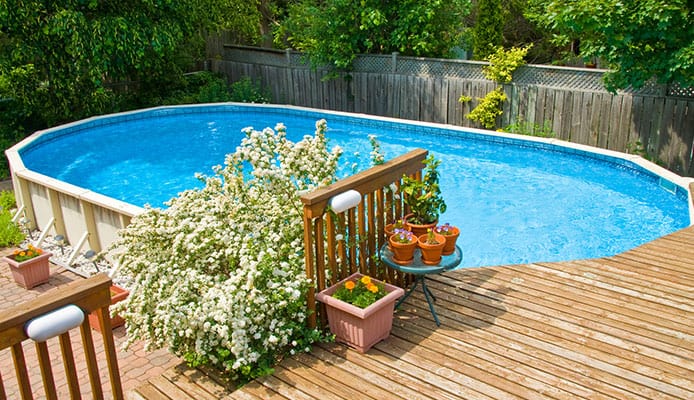
Q: What Are Pool Liners For Above Ground Pools?
A pool liner is a barrier that goes inside the above ground pool. It comes in direct contact with the water and holds it in. Liners are made of thick vinyl and attached to the top edge of your pool, covering the whole inner surface (bottom and walls).
Q: Why Do I Need Pool Liners?
Their main task is keeping the water inside the pool and preventing any leaks. By keeping the water in, they allow the pool to retain its shape and help support the structure. Also, a thicker liner can work as a protective layer and prevent damage to the walls.
Q: How To Clean Pool Liner?
Cleaning the liner properly will significantly lengthen its lifespan and improve durability. This way you’ll remove dirt and algae from the walls and prevent any damage that might lead to cracks. Here are a few simple steps you can follow when cleaning the liner:
- Using a pool brush, scrub all the liner surfaces thoroughly (dirt and algae that are stuck to the walls and floor)
- Once everything is off, use a manual or automatic vacuum to pick up as much floating debris as possible
- Balance the chemicals in the pool water – test it and make sure everything is in order
- Shock the pool water – this kills off all the bacteria and algae both in the water and on the liner
- Turn on the pool filter and let it run for several hours (until the water is clear again)
Cleaning an above ground pool is a bit different from an in-ground pool – the vinyl liner is more gentle than tiles or concrete. Still, the liner needs to be scrubbed properly from time to time to ensure it stays crack-free for a longer time. In addition, maintaining the pool chemistry properly is very important for liner durability.
Q: Why Do Different Companies Have The Same Pool Liner Patterns With Different Names?
This is because the manufacturers are getting the liners from the same large supplier. Smaller manufacturers don’t have their own designs, but choose to buy pre-made liners. Other (larger) manufacturers have their patented prints that only they sell. Regardless of the name on the box, look for things that really matter – type, size, material, and thickness.
Q: Does Pool Liner Thickness Matter?
Yes, pool liner thickness matters. Thicker liners can resist cracks and damage better, and usually last much longer when compared to thin liners. On the flip side, they are harder to install and often have annoying wrinkles in the surface. The price is also proportional to thickness – thicker liners are more expensive.
Q: When Should I Replace Pool Liner?
You'll know it's time to replace the liner when you've noticed that it had started to deteriorate significantly. An accidental leak in the liner can be fixed, but if the whole liner has become brittle and damaged, it’s time for a new one.
As we’ve said earlier, a liner usually lasts from 5-10 years. It's best replace it before it breaks down completely, and avoid damage to the pool structure and other pool components.
Globo Surf Overview
A well-made pool liner for above ground pool is essential for the pool’s functionality. After all, it’s the component that keeps the water inside. Replacement above ground pool liners come in many different shapes and sizes, so you should properly match them with your pool to avoid headaches.
Whether you’re opting for above ground beaded pool liners or any other type, make sure you know the right dimensions and that you can properly install it in your pool. If you do this right, your new top rated above ground pool pad will make sure you can enjoy your swimming pool for many seasons to come.
More Above Ground Pool Reviews:

